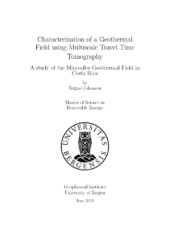Characterization of a Geothermal Field using Multiscale Travel Time Tomography - A study of the Miravalles Geothermal Field in Costa Rica
Master thesis
Permanent lenke
https://hdl.handle.net/1956/20048Utgivelsesdato
2019-06-15Metadata
Vis full innførselSamlinger
- Master theses [123]
Sammendrag
The objective of this thesis is to investigate how travel time tomography and earthquake relocations can improve the understanding of the Miravalles geothermal field in Costa Rica. Finding the answer to this research question requires a significant amount of work divided into different stages. First, the seismic waveform data was preprocessed, i.e. the arrival times of the P-waves were selected in SEISAN. After that, a ray tracing code was written. This was done by solving the ray equations numerically using the symplectic Euler method. In order to determine the origin of an earthquake a new grid search approach called P-wave single difference was developed. In contrast to conventional grid search methods which use the calculated arrival times and origin times, this method only requires the calculated travel time differences. Subsequently, the travel time tomography code was written and tested using various synthetic models. Finally, a new version of the multiscale travel time tomography was developed and applied to the data obtained in the first step. Unique to the method developed in this thesis, is that it employs three different parameterizations of the velocity model and that these are implemented progressively from the largest to the smallest. Earthquakes are also relocated for each new velocity model using the P-wave single difference algorithm. The tomography yielded the first image of the Miravalles geothermal reservoir, showing that there is a correlation between locations of the earthquakes, the area of production and the geothermal reservoir. They furthermore indicated that the geothermal reservoir and the seismic activity are restricted by the Guayabo caldera border and la Fortuna graben. Lastly, a high velocity ellipsoid-shaped structure also became apparent. This may be a possible intrusion that has cooled. The relatively poor coverage in this area, however, makes it impossible at this stage to state this with absolute certainty; the possibility remains that it is an artifact of the tomography. This and other features can only be investigated further by employing more data and preferably a denser station coverage. Regardless, it is clear that the research conducted in this thesis shows that the locations of earthquakes and the P-wave velocity tomography yield quite a lot of information about the subsurface structure, and that this knowledge can provide useful insight to the operators of the Miravalles geothermal field. The outcome of this study also suggests that geothermal reservoirs in general should be monitored with a dense enough network of seismometers, as this is probably the best way to image and monitor such reservoirs.
